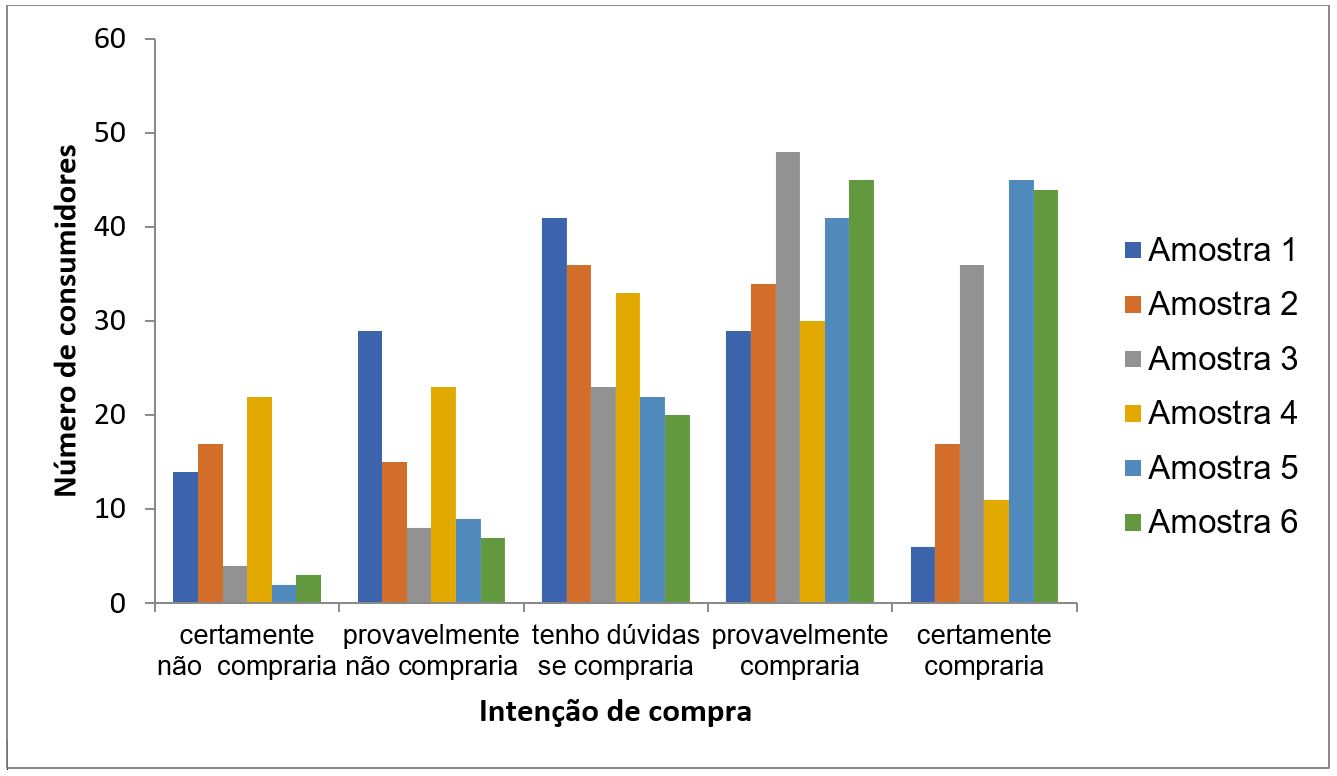|
Aparência
|
| Cor creme |
Cor creme clara característica de creme de leite |
Pouco: leite integral (Paulista®)
Muito: 100 mL de leite desnatado (Paulista®) com 0,1 g de café solúvel original (Nescafé®) |
| Viscosidade aparente |
Facilidade da amostra em escorrer pelo recipiente |
Pouco: iogurte batido sabor baunilha (Danone®)
Muito: iogurte grego (Vigor®) |
| Consistência |
Escoamento do creme ao ser suspenso com colher e devolvido ao copo |
Pouco: iogurte batido sabor baunilha (Danone®)
Muito: iogurte grego (Vigor®)com 2 mL de leite desnatado (Paulista®) |
| Homogeneidade |
Capacidade do creme de leite manter sua aparência e estrutura em toda sua extensão, sem grumos e/ou grânulos |
Pouco: 10 g de ricota (Queijos da Fazenda JB®) com 30 g de creme de leite (Nestlé®)
Muito: 100 g de requeijão (Vigor®) |
| Aeração |
Presença de bolha de ar no creme de leite |
Nenhum: leite desnatado (Paulista®)
Forte: álcool em gel (Zupp®) |
| Brilho |
Habilidade do creme de leite em refletir a luz |
Pouco: sobremesa láctea sabor chocolate branco (Danette, Danone®)
Muito: leite integral (Paulista®) |
|
Aroma
|
| Leite |
Aroma característico de leite |
Pouco: leite desnatado (Paulista®)
Muito: leite integral (Leitíssimo®) |
| Creme de leite |
Aroma característico de creme de leite fresco |
Pouco: 50 mL de creme de leite diluído (Nestlé®) em 100 mL de leite integral (Paulista®)
Muito: creme de leite fresco (Tirolez®) |
| Manteiga |
Aroma característico de manteiga |
Nenhum: leite desnatado (Paulista®)
Forte: manteiga com sal (Aviação®) |
| Requeijão |
Aroma característico de requeijão |
Nenhum: leite desnatado (Paulista®)
Forte: requeijão (Vigor®) |
| Leite em pó |
Aroma característico de leite em pó |
Nenhum: leite desnatado
Forte: 2 g de leite em pó diluído (Ninho, Nestlé®) em 50 mL de leite integral (Paulista®) |
| Doce |
Aroma doce relacionado à presença de açúcares |
Pouco: 50 mL de leite integral (Paulista®) com 15 g de creme de leite fresco (Tirolez®) batido e 5 g de açúcar refinado (União®)
Muito: 50 mL de creme de leite fresco (Tirolez®) com 5 g de açúcar refinado (União®) e 10 g de iogurte grego sabor baunilha (Vigor®) |
|
Sabor
|
| Leite |
Sabor característico de leite integral |
Pouco: leite desnatado (Paulista®)
Muito: leite integral (Paulista®) |
| Manteiga |
Sabor característico de manteiga |
Nenhum: 50 mL leite desnatado (Paulista®) com 50 mL de água
Forte: manteiga sem sal (Aviação®) |
| Doce |
Gosto doce relacionado à presença de açúcares |
Nenhum: iogurte natural desnatado (Nestlé®)
Forte: 50 mL de iogurte batido (Danone®) com 20 mL de creme de leite (Nestlé®) |
| Leite em pó |
Sabor característico de leite em pó |
Nenhum: leite desnatado (Paulista®)
Forte: 50 mL de leite integral (Paulista®) com 2 g de leite em pó (Ninho, Nestlé®) |
| Requeijão |
Sabor característico de requeijão |
Nenhum: leite desnatado (Paulista®)
Forte: requeijão (Vigor®) |
| Nata |
Sabor característico de nata |
Pouco: leite integral (Paulista®)
Muito: 10 mL de creme de leite fresco (Tirolez®) com 50 g de nata (Queijos da Fazenda JB®) |
|
Textura
|
| Corpo |
Sensação de preenchimento na boca |
Pouco: iogurte batido (Danone®)
Muito: iogurte grego (Vigor®) |
| Textura gordurosa |
Sensação gordurosa durante a ingestão |
Pouco: leite integral (Paulista®)
Muito: manteiga com sal (Aviação®) |
| Residual gorduroso |
Sensação gordurosa que permanece até 15 segundos após a ingestão |
Pouco: leite integral (Paulista®)
Muito: nata (Queijos da Fazenda JB®) |
| Fluidez |
A facilidade do creme de leite de ser engolido |
Pouco: iogurte grego (Vigor®)
Muito: iogurte batido (Danone®) |

 Thumbnail
Thumbnail
 Thumbnail
Thumbnail
 Thumbnail
Thumbnail
 Thumbnail
Thumbnail



